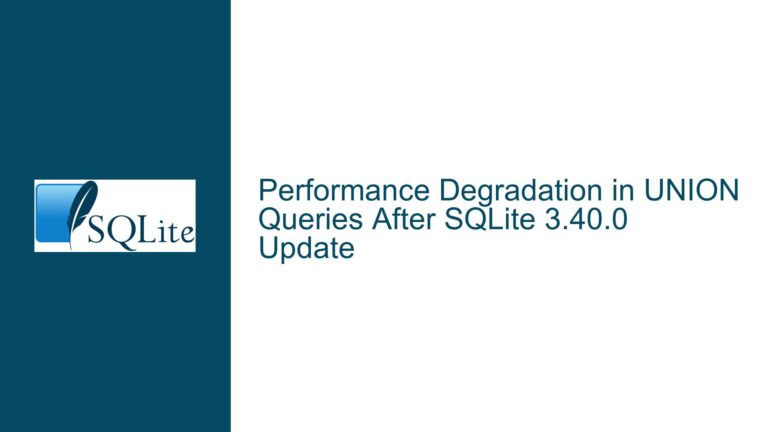Random Slow SELECT Queries with FTS5 Joins Due to Caching Issues
Inconsistent Query Performance with FTS5 Tables and External Content Joins
The core issue revolves around inconsistent query performance when executing SELECT statements involving joins between an FTS5 table and an external content table. Under normal circumstances, queries execute in approximately 50ms or less. However, there are sporadic spikes where query execution times balloon to 2-3 seconds. These spikes appear to be random but are more pronounced when a user performs a search after a period of inactivity or after the Node.js processes have restarted. The randomness of the issue, combined with the lack of a clear pattern, suggests a caching-related problem. The database setup involves SQLite 3.38.5 with FTS5 tables, an external content table, and a Node.js application using the better-sqlite3 library. The database files are stored on an AWS EC2 instance with 4GB of RAM, and the default SQLite settings are in use, including the absence of Write-Ahead Logging (WAL) mode.
The FTS5 table is defined with 17 fields and uses the unicode61 tokenizer with diacritic removal and custom token characters. The table is synchronized with an external content table using triggers, as recommended in the SQLite documentation. The database files are updated by copying them to a temporary location, writing changes, and then replacing the original file. After each search operation, the database connection is explicitly closed to release inodes, ensuring the file can be overwritten during updates. Despite these measures, the random query performance spikes persist, particularly when joining the FTS5 table with the external content table.
The randomness of the issue makes it challenging to diagnose. While the initial slow queries after inactivity or process restarts can be attributed to cache misses, the sporadic spikes during active usage are more perplexing. The user has attempted to mitigate the issue by increasing the mmap_size PRAGMA to 1GB, but the impact of this change remains unconfirmed. The problem is further complicated by the fact that the database files can grow to hundreds of thousands of megabytes, and users typically have thousands of entries in their FTS5 tables. This combination of factors creates a scenario where caching behavior is critical to performance, yet the current setup does not provide consistent caching results.
Potential Causes of Random Query Performance Spikes
The random query performance spikes can be attributed to several potential causes, each of which interacts with the others in complex ways. The primary suspect is SQLite’s caching behavior, particularly in relation to the FTS5 table and the external content table. SQLite relies on a page cache to store frequently accessed database pages in memory, reducing the need for disk I/O. However, the default cache size may be insufficient for the workload described, leading to frequent cache misses and subsequent performance degradation.
Another factor is the absence of Write-Ahead Logging (WAL) mode. While WAL mode is primarily designed to improve write performance and concurrency, it also has implications for read performance. In WAL mode, readers do not block writers, and vice versa, which can lead to more consistent query performance. The decision to disable WAL mode in favor of maximum read performance may be counterproductive, as it limits SQLite’s ability to manage concurrent access efficiently.
The use of the better-sqlite3 library introduces additional considerations. While this library provides a synchronous API that simplifies database interactions, it may also contribute to performance variability. For example, explicitly closing the database connection after each search operation ensures that inodes are released, but it also flushes the page cache, forcing subsequent queries to reload data from disk. This behavior could explain why queries are slow after periods of inactivity or process restarts.
The size of the database files and the number of entries in the FTS5 table further exacerbate the issue. With database files potentially reaching hundreds of thousands of megabytes, the working set may exceed the available memory, leading to frequent cache evictions. The FTS5 table’s tokenization and indexing mechanisms also add overhead, particularly when joining with the external content table. The unicode61 tokenizer, while effective for text search, requires additional processing, especially when combined with diacritic removal and custom token characters.
Finally, the AWS EC2 instance’s resource constraints may play a role. With only 4GB of RAM, the system may struggle to maintain an adequate page cache for large database files. The presence of three Node.js processes further divides the available memory, increasing the likelihood of cache contention. These factors, combined with the random nature of the query spikes, suggest that the issue is multifaceted and requires a comprehensive approach to diagnose and resolve.
Diagnosing and Resolving Random Query Performance Spikes
To address the random query performance spikes, a systematic approach is required. The first step is to gather detailed performance metrics to identify patterns or correlations that may not be immediately apparent. Enabling SQLite’s query profiling features can provide insights into query execution times, cache hits, and disk I/O. The sqlite3_profile and sqlite3_trace functions can be used to log detailed information about each query, including the time taken for each step of the execution process.
Once sufficient data has been collected, the next step is to optimize SQLite’s caching behavior. Increasing the cache_size PRAGMA can help reduce cache misses by allowing more database pages to be stored in memory. The mmap_size PRAGMA, which has already been increased to 1GB, should be monitored to determine its impact on performance. If the working set exceeds the available memory, consider reducing the size of the database files or partitioning the data to improve cache efficiency.
Reevaluating the decision to disable WAL mode is also recommended. While WAL mode introduces additional complexity, it can improve both write and read performance by reducing contention between readers and writers. Enabling WAL mode and adjusting the wal_autocheckpoint PRAGMA can help balance performance and resource usage. Additionally, using the journal_mode PRAGMA to set the journal mode to MEMORY or OFF can reduce disk I/O, further improving performance.
The use of the better-sqlite3 library should also be reviewed. While the library’s synchronous API simplifies database interactions, it may not be the best choice for high-performance applications. Consider using an asynchronous library, such as node-sqlite3, which can handle concurrent queries more efficiently. If sticking with better-sqlite3, avoid explicitly closing the database connection after each query, as this flushes the page cache and forces subsequent queries to reload data from disk. Instead, maintain a persistent connection and use connection pooling to manage resources effectively.
Optimizing the FTS5 table and its interaction with the external content table is another critical step. Review the tokenizer configuration to ensure it meets the application’s requirements without introducing unnecessary overhead. If the unicode61 tokenizer is not essential, consider using a simpler tokenizer, such as porter, which may reduce processing time. Additionally, ensure that the external content table is properly indexed to facilitate efficient joins. Creating indexes on the columns used in the join conditions can significantly improve query performance.
Finally, consider upgrading the AWS EC2 instance to one with more memory. With only 4GB of RAM, the system may struggle to handle large database files and multiple Node.js processes. Upgrading to an instance with 8GB or more of RAM can provide additional headroom for the page cache, reducing the likelihood of cache misses and improving overall performance.
By following these steps, it is possible to diagnose and resolve the random query performance spikes. The key is to approach the issue systematically, gathering data, optimizing SQLite’s configuration, and making informed decisions about the application’s architecture and resource allocation. With careful analysis and targeted optimizations, consistent query performance can be achieved, even in demanding environments.






